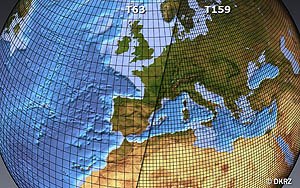Complexity
So far, climate modeling has concentrated mainly on the simulation of physical components and their coupling, such as atmospheric and oceanic circulation and the respective exchange processes at the sea surface. DKRZ's state-of-the-art supercomputer enables scientists to integrate chemical and biological processes, as well as investigate the interaction of the climate and the socio-economic system.
The ultimate ambition of the international climate and global change research community is the development of a complex model of the earth system that comprises all physical and biogeochemical interactions of the atmosphere, ocean, cryosphere and the biosphere as well as social issues.
Spatial Resolution of Models

Even today, the newest supercomputers are still incapable of computing comprehensive climate models at the required spatial resolutions.
Ensembles

The more powerful the computer, the more extensive are the ensembles - and the reliability of the final result.
Long Simulation Runs
Many scientific investigations require simulations of the earth system over a period of several centuries. To accomplish such experiments within a reasonable time frame, many simulated years need to be computed within a day. But even with the fastest computers available today, climate events such as ice ages take many months to compute.
Parametrization
Many physical processes occur on quite small scales compared to the spatial resolution of the model grid on which
they are computed. For this reason they cannot yet be adequately represented in present-day climate models. The
formation of clouds is an example of such a non-representable process. But clouds cannot be neglected in climate models
because they play an important role for temperature in the climate system: They reflect solar radiation, thereby
augmenting the greenhouse effect. Climate modelers need to parametrize the influence of clouds in the model and
find a suitable representation of the mean influencing factors. Similar parametrizations are required for the exchange
of heat and water vapor with the oceans and for several other processes.
